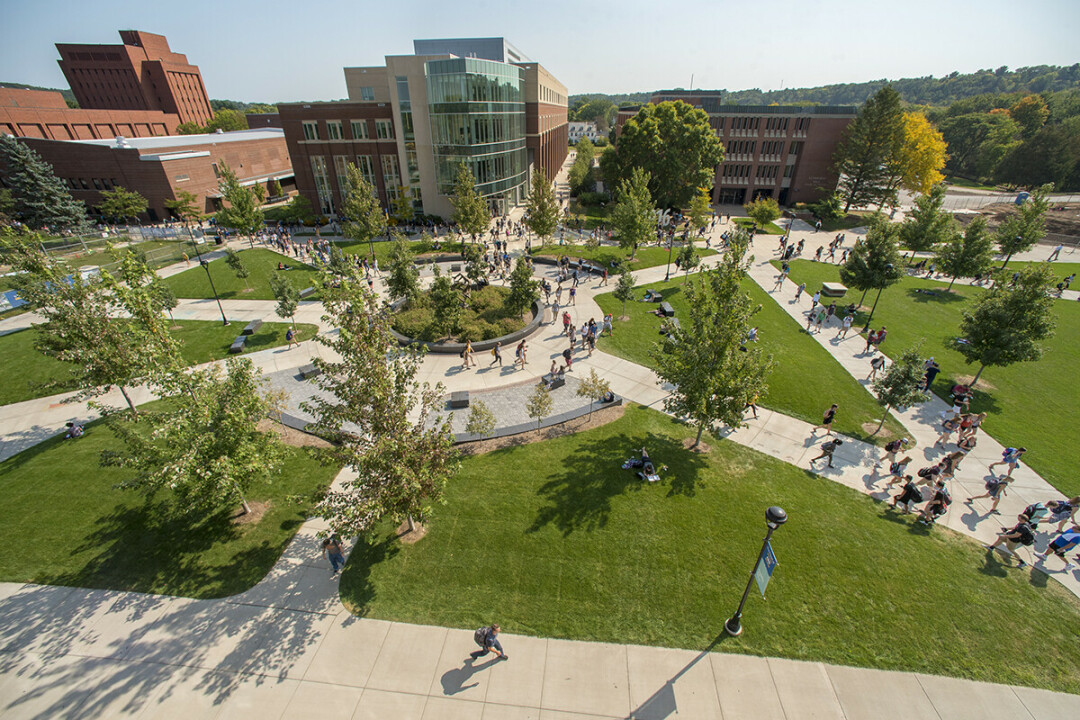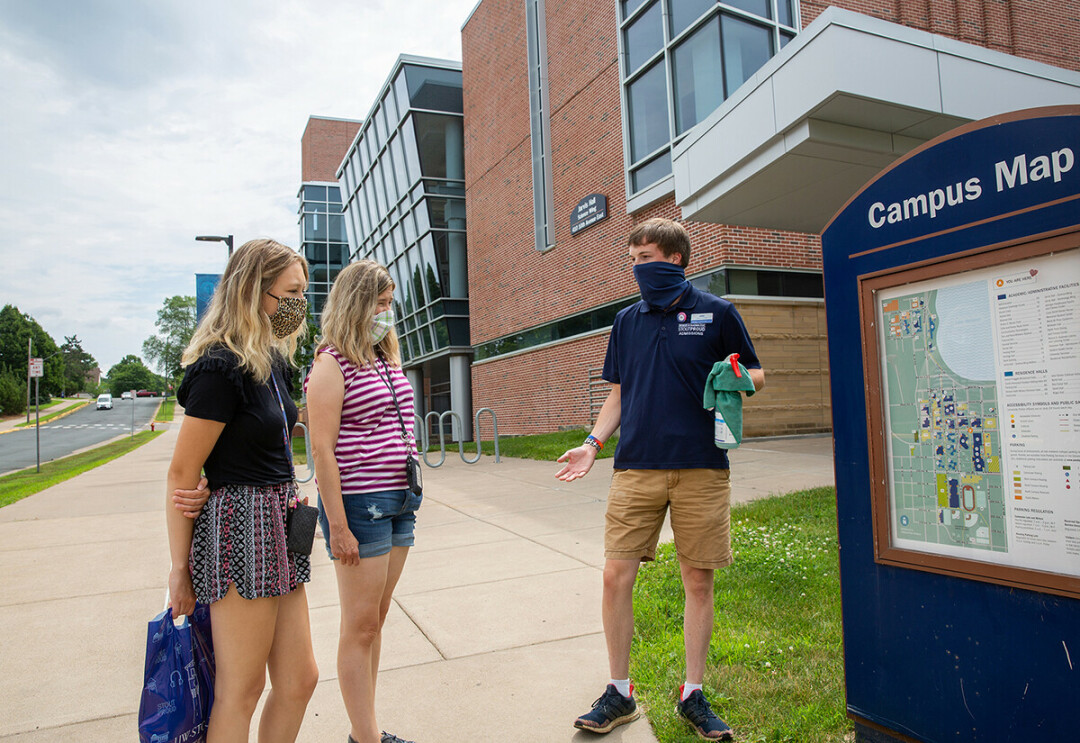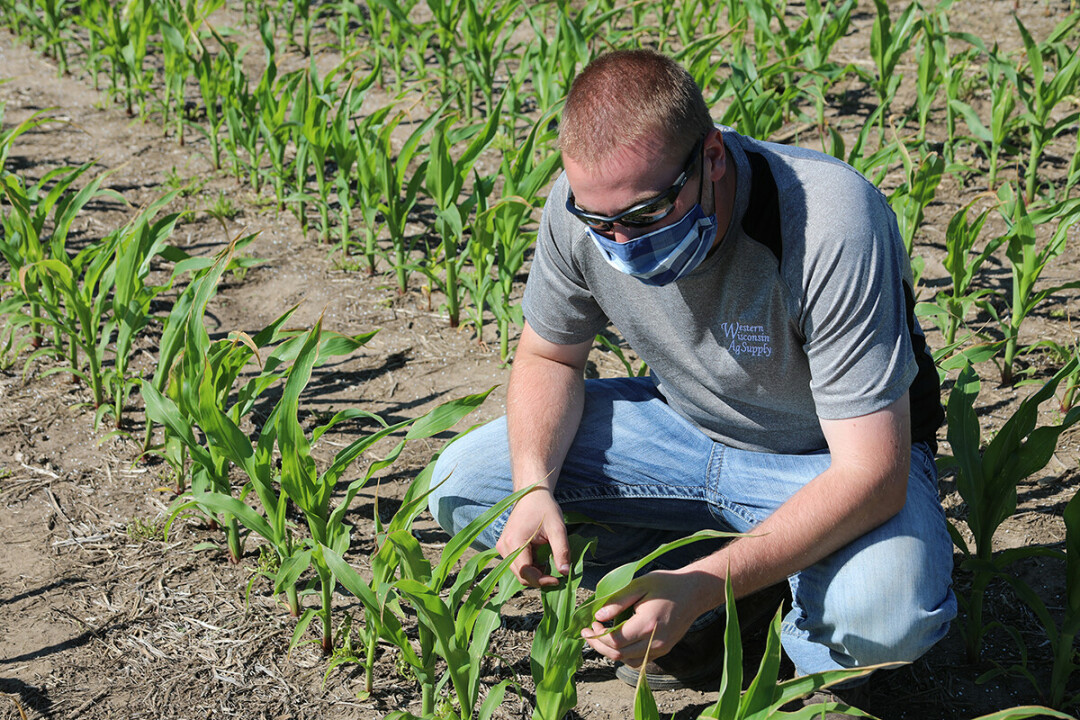Colleges Cautiously Coming Back Amid Pandemic
UWEC, UW-Stout, and CVTC outline plans for in-person, online semester
Evelyn Nelson, Hayley Jacobson, Julie Quinn |

UW-EAU CLAIRE
UW-Eau Claire is working from the top down to ensure student safety this coming semester.
When the fall semester begins Sept. 2, some classes will be held online, sanitation stations have been placed all around campus, social distancing guidelines line the halls and front doors of each building, and – in case of the worst – one of the residence halls has been converted to a quarantine building for any Blugolds who test positive for the coronavirus.
Classroom capacities have been cut down for social distancing. According to Jan Larson, one of the largest lecture halls on campus, Hibbard 100, which is capable of seating 300 students, has been spaced out to accommodate up to 56 students at a time.
“It’s going to be different, but
I believe we can make it successful.”
– UWEC Chancellor James Schmidt,
on the upcoming semester
“All classrooms and identified learning spaces have been assessed and configured to allow for social distancing,” said Larson, professor and chair of UWEC’s department of communication and journalism. Classes that were too large or could not adhere to social distancing guidelines were moved online, Larson said, while others were moved online to accommodate the class’ needs for group work and group interaction.
There will be no in-person classes larger than 50 students, according to UW-Eau Claire’s public information’s officer, Michael Knuth. However, most classes will be held as hybrid classes. Hybrid classes will use both online and in-person methods of teaching to help students learn effectively and safely, Knuth said.
Students moving into the resident halls now have five days instead of two to drop off their things, according to Quincy Chapman, director of housing and residence life. There is a limit on how many guests a student can have accompanying them. Students can bring up to two visitors if one visitor is a parent. Masks are required while inside halls.
Sanitation stations, tables or cardboard stands, have been placed in high-traffic areas, such as all the residence halls and campus buildings along upper and lower campus, including in the Pablo Center and off-campus residence halls. These stands, put up by the university students hired to help the campus meet social distancing guidelines, each contain a one-gallon tub of hand sanitizer and a one-gallon tub of antibacterial wipes.
“I’m confident we’ll be able to bring students back to campus safely,” Chancellor James Schmidt said, “and I look forward to this school year. It’s going to be different, but I believe we can make it successful.”
The university has launched the Blugold Flight Plan, a set of guidelines for beginning the semester safely. Details can be found at www.uwec.edu/about/blugold-flight-plan.

UW-STOUT
All summer, universities have raised the question of how best to return in person to campus this fall. UW-Stout’s approach: “Think differently.”
“Our main concern: keeping our students, faculty, and staff safe as we reopen this fall,” Douglas Mell – special assistant to Chancellor Katherine Frank – said in light of the school’s announcement to restore in person instruction for the fall.
In line with fellow UW schools, Stout has reimagined communal safety standards through their own COVID-19 campaign – “Safer@Stout” – which will encourage faculty, staff, and students to follow the proper health and safety practices to keep themselves and the campus safe.
The campaign will practice safety regimens from federal, state, and local health experts to prevent the spread of the coronavirus. In addition, the university will be working alongside the Dunn County Community Recovery Task Force.
Jerry Hui, director of choral activities and performing arts, said the school of Art and Design has taken the summer to overcome obstacles it faced during the campus’ initial COVID-19 closure last spring.
“As of early July, some of us (professors) have been preparing to teach our classes online,” Hui said. “To really reconsider the entire curriculum, so that we can design the courses so that it is fitting to be taught online.”
Summer preparations by the university also included a density study of all classrooms and labs – to determine the capacity each space could accommodate – after applying established social distancing parameters.
The collaborative efforts between administration and each professor’s requirements for the upcoming fall, Hui said, have been open and flexible when adjusting to in person or hybrid instruction.
Because of the risks found from gathering in large groups, Hui has now altered select courses of his own, to be taught in a socially distanced, outdoor setting as weather permits.
“On the department level, things have been very smooth,” Hui said. “With the choir, I had to reserve the outdoor space that we want to rehearse at. But, it was likewise pretty easy, especially after I explained all the reasons, all my research, and what we’re going to do.”
Overall, Hui, other faculty, and staff on campus said the education of students will continue to be the top priority when returning this fall. “We want to emphasize, no matter how we’re going to meet, we care about our students a lot,” Hui said. “We want to work with them. Even if in the foreseeable future, we are going to work remotely online. We want to make it happen. We just need to know how we can help make the whole process better.”
UW-Stout’s semester will begin Sept. 9. More information on frequently asked questions can be found at www.uwstout.edu/students-families-0.

CHIPPEWA VALLEY TECHNICAL COLLEGE
With less than two weeks until the beginning of fall class, Chippewa Valley Technical College President Bruce Barker outlined the college’s plan for the upcoming fall semester.
Courses will be held online and in-person. “A large number of students won’t even need to come to campus,” Barker said. All general electives will be held online, along with the majority of businesses programs.
Some programs present students with a MyChoice option, offering both an online and face-to-face format varying week to week, depending on the student’s personal preferences.
If students choose to attend in-person classes, they can expect smaller class sizes, mask requirements, maintenance of social distancing, and an increase in sanitation and cleaning throughout the building.
There will be limited entrances and exits as well as a screening questionnaire upon entry. Certain areas of buildings will be restricted or limited for both student and faculty access. All CVTC campuses will remain closed to the public at this time.
Additional resources, including student services, tutoring services, financial aid, and registration, are also available to students via face-to-face or online access, though the hours may be limited.
“We realize this is a hard decision to make,” Barker said, “There are a lot of unknowns.”
Stressing their “innovative and applied” education mission, Barker encourages students to continue their education. While most colleges transitioned to an online format last spring, “ a number of our programs were determined to be essential workers,” Barker said. “We still were allowed to meet face-to-face (which) reflects the type of programs we have – essential occupations to our community.”
CVTC’s fall semester begins Aug. 24. More information can be found at www.cvtc.edu/about-cvtc/consumer-disclosures/health-advisory-updates.


















